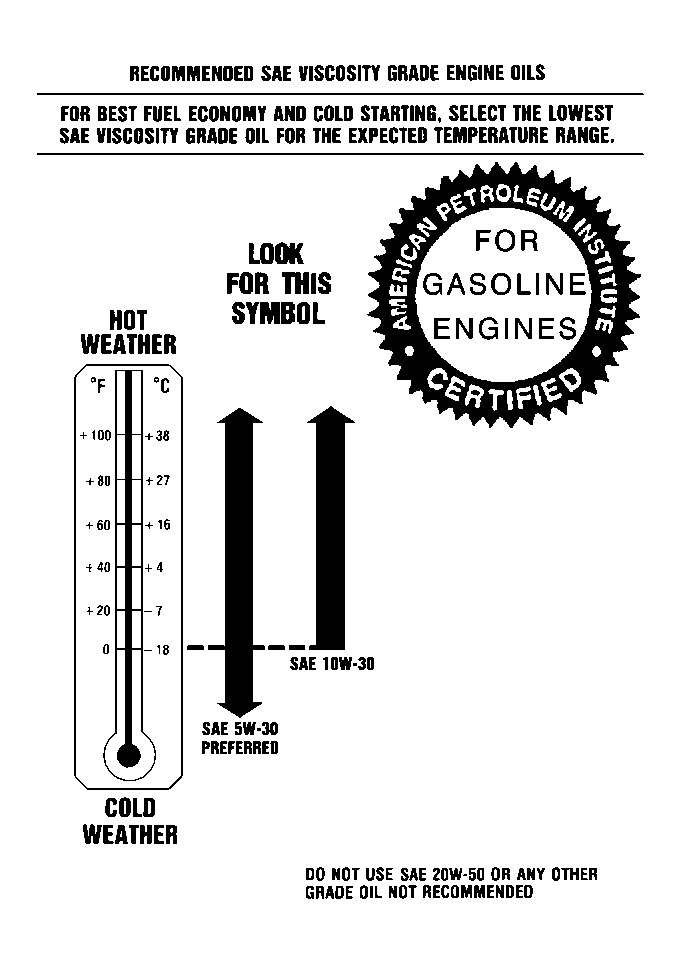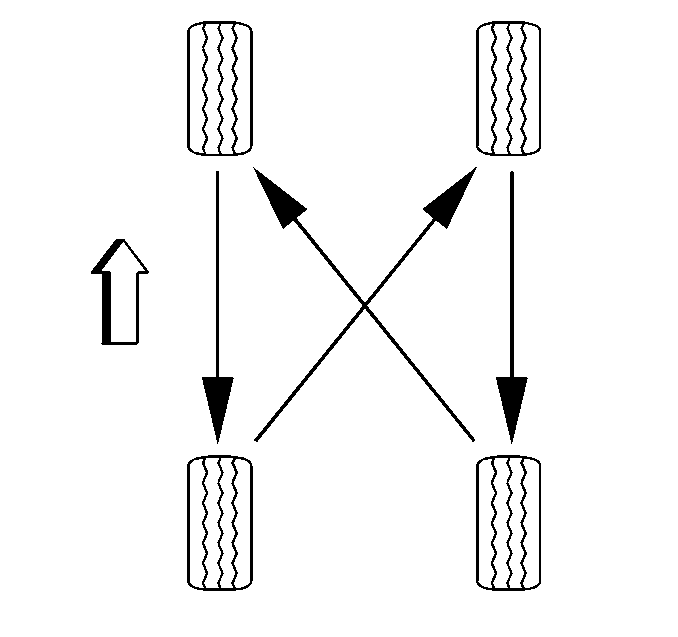Engine Oil
If the LOW OIL LEVEL message appears on the Driver Information Center (DIC), test the engine oil level right away. Although the driver should test the engine oil level regularly, this message is an added reminder.
What Kind of Engine Oil to Use
Two factors should be considered when determining type of oil to use in a vehicle:
| • | The engine requires oil meeting GM Standard GM6094M. Use only oil that meets this standard. |

| • | SAE 5W-30 is the only viscosity grade recommended for use in GM vehicles. |
| - | If the temperature is greater than -18°C (0°F) and if SAE 5W-30 is not available, you may use SAE 10W-30. |
| - | Oils meeting these requirements should also have the starburst symbol on the container. This symbol indicates that the oil has been certified by the American Petroleum Institute (API). |
| - | If the temperature falls below -20°C (-4°F), it is recommended that you use either an SAE 5W-30 synthetic oil or an SAE 0W-30 oil. Both will provide easier cold starting and better protection for your engine at extremely low temperature. |
Engine Oil Additives
Do NOT engine oil additives. The recommended oils with the starburst symbol that meet GM Standard GM6094M are all that is needed for good performance and engine protection.
When to Change Engine Oil-GM Oil Life System
The vehicle has a computer system that tells the owner when to change the engine oil and filter. This system is based on engine revolutions and engine temperature, and not on mileage. Based on driving conditions, the mileage at which an oil change will be indicated can vary considerably. For the oil life system to work properly, the system must be reset every time the oil is changed.
When the system has calculated that oil life has been diminished, the system will indicate that an oil change is necessary. A CHANGE ENGINE OIL message in the Driver Information Center (DIC) will come on. The oil should be changed within the next two gasoline fill-ups after this message appears. It is possible that, if the car is being driven under the best condition, the oil life system may not indicate that an oil change is necessary for over a year. However, the engine oil and filter must be changed at least once a year and at this time the system must be reset
If the system is ever rest accidentally, the oil must be changed within 5000 km (3,000 mi) since the last oil change. Reset the oil life system whenever the oil is changed.
Tire and Wheel Inspection and Rotation

| • | Tires should be rotated every 8 000-13 000 km (5,000-8,000 mi). |
| | Any time you notice unusual wear, rotate the tires as soon as possible and test the wheel alignment. Also inspect for damaged tires or wheels. Refer to
Tire Rotation
in Tires and Wheels. |
| • | Make sure the spare tire is stored securely Push, pull, and then try to rotate or turn the tire, If it moves, use the folding wrench to tighten the cable. Refer to
Compact Spare Tire Replacement
in Tires and Wheels. |
| • | The purpose of regular rotation is to achieve more uniform wear for all tires on the vehicle. The first rotation is the most important. Refer to
Scheduled Maintenance
for scheduled rotation intervals. |
| | When rotating your tires, always use the correct rotation pattern shown here. |
| • | Do not include the compact spare tire in your tire rotation. |
| • | After the tires have been rotated, adjust the front and rear inflation pressures Refer to
Tire Placard
. |
Engine Air Cleaner/Filter
Inspect the air cleaner filter every oil change and replace at the first oil change after 40 000 km (25,000 mi).
Automatic Transaxle Fluid
It is not necessary to check the transaxle fluid level. A transaxle fluid leak is the only reason for fluid loss. Change both the fluid and filter every 83 000 km (50,000 mi) if the vehicle is mainly driven under one or more of these conditions:
| • | In heavy city traffic where the outside temperature regularly reaches 32°C (90°F) or higher |
| • | In hilly or mountainous terrain |
| • | When doing frequent trailer towing |
| • | Uses such as found in taxi, police or delivery service |
Manual Transmission Fluid
It is not necessary to check the transmission fluid level. A transmission fluid leak is the only reason for fluid loss. Refer to
Fluid and Lubricant Recommendations
.
Hydraulic Clutch
The hydraulic clutch linkage is self-adjusting. This system does not have its own reservoir. The reservoir receives fluid from the brake master cylinder reservoir. Refer to
Master Cylinder Reservoir Replacement
.
Cooling System
The cooling system is filled with DEX-COOL engine coolant. This coolant is designed to remain in the vehicle for 5 years or for 166 000 km (100,000 mi), whichever occurs first, if you add only DEX-COOL extended life coolant.
Power Steering Fluid
It is not necessary to regularly check power steering fluid unless you suspect there is a leak in the system or you hear an unusual noise. A fluid loss in this system could indicate a problem. Have the system inspected and repaired. Refer to
Power Steering Fluid Leaks
in Power Steering
Windshield Washer Fluid
When adding windshield washer fluid, be sure to read the instructions before use. If operating the vehicle in an area where the temperature may fall below freezing, use a fluid that has sufficient protection against freezing.
Brake Fluid
Your brake master cylinder reservoir is filled with DOT-3 brake fluid.
There are only two reasons why the brake fluid level in the reservoir might go down:
| • | The brake fluid goes down to an acceptable level during normal brake lining wear. When new linings are put in, the fluid level goes back up. |
| • | The fluid may be leaking out of the brake system. If so, fix the brake system. |
Adding brake fluid will not correct a leak. If you add fluid when the linings are worn, then the reservoir will contain too much fluid when new brake linings are installed. You should add or remove brake fluid, as necessary, only when work is being done on the brake hydraulic system.
Inspect brake lines and hoses for proper hook-up binding, leaks, cracks or chafing. Inspect disc brake pads for wear. Refer to
Brake Pad Inspection
in Disc Brakes. Inspect the rotors for poor surface condition. Inspect other brake system components, including brake calipers and the parking brake. Test the parking brake adjustment. The brakes may need to be inspected more often if the customer's driving habits or conditions result in frequent braking.


